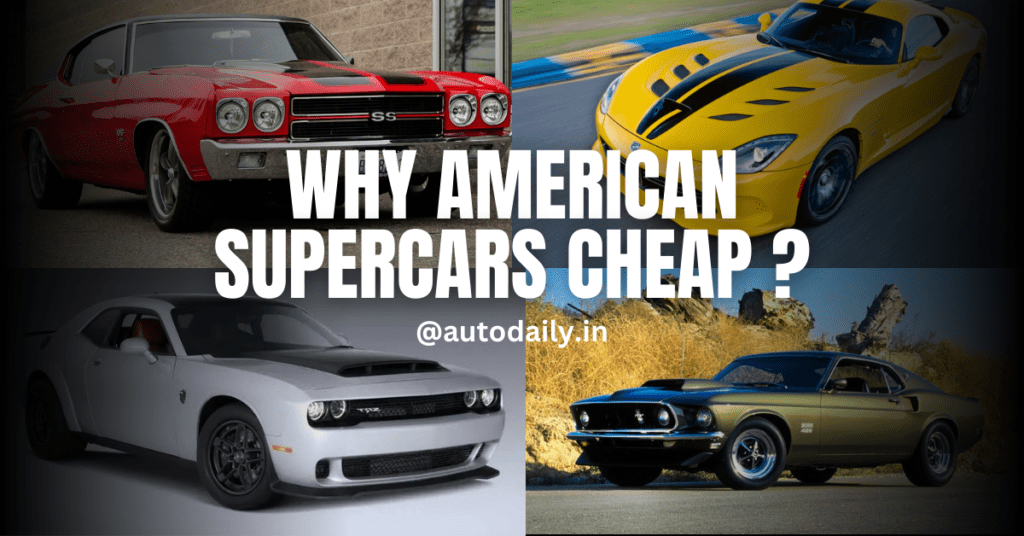American Supercars cheaper than Fortuner!
The Ford Mustang this sports car is a standout in the US. The base model boasts a 2.3-liter EcoBoost engine, generating 315 horsepower and 474 Nm of torque. Now, let’s compare it to the base variant of the German Porsche 911, equipped with a 3-liter flat-six engine, producing 379 BHP and 448 Nm of torque. Power and torque-wise, they’re quite similar, but there’s a significant price difference.

Pricing
The base Porsche 911 starts at $114,000 in the US, which equals INR 95 Lacs. On the flip side, the Mustang starts at $30,000, just INR 25 Lacs. And that’s just the base variants; the top models have a substantial price gap. The Mustang’s top model, featuring a V8 engine with 500 HP, starts at INR 63 Lacs. In contrast, the Porsche 911 S/T begins at INR 2.4 Crores. One could buy four top Mustang models for the price of a single top Porsche 911 variant.
Comparison with Other American and European Cars

This pricing trend isn’t exclusive to the Mustang and Porsche. Comparing American muscle cars like the Dodge Challenger, Viper, and Chevrolet Corvette to European counterparts like the Mercedes AMG GT, BMW M5, and Lamborghini Huracan, we see a consistent pattern. American sports cars generally have lower starting prices.
Historical Background
To understand this pricing difference, let’s delve into history. The definition of a sports car, according to automotive journalist Cyril Posthumous, emphasizes performance over carrying capacity. Originally, sports cars were born in Europe, reflecting German industry values of individual craftsmanship and small batches. After World War 2, Americans, lacking such cars, imported European sports cars. Recognizing an opportunity, American brands started producing sports cars similar to European ones, such as the Chevrolet Corvette EX122 in 1953.
Evolution and American Approach
However, European sports cars were not practical for American roads due to smaller engines. American brands addressed this by producing sports cars with larger engines, favoring mass production for affordability. This strategy gave rise to muscle cars evolving into sports cars. Unlike sleek European designs, American sports cars often had muscular aesthetics, reflecting the focus on powerful engines rather than aerodynamics.
Fuel Crisis and Regulatory Influence
A shift occurred when major American film stars featured these cars in movies. During the fuel crisis of 1985, the US government focused on fuel efficiency, exempting sports and muscle cars from stringent regulations. This exemption allowed American automakers to concentrate on these powerful cars, capitalizing on their existing popularity.
Economies of Scale
One significant factor contributing to the affordability of American sports cars is economies of scale. While European sports cars are often handcrafted in small batches, American sports cars are mass-produced. This high production volume allows American brands to offer these cars at more accessible prices.
Quality and Materials
Quality-wise, American sports cars may lag behind European counterparts. European sports cars often feature superior interior layouts, leather quality, and additional creature comfort features. American cars typically use steel in construction, while European sports cars use aluminum, and high-end models may even utilize carbon fiber.
Technological Advancements
The difference in pricing is also influenced by the level of technological advancements. European sports cars invest heavily in R&D for better aerodynamics, smaller engines, and electronically controlled systems. American sports cars, while powerful, may lack these sophisticated technologies, contributing to their lower prices.
Handling and Performance
Another distinction lies in handling and performance. American sports cars are often criticized for poor handling, attributed to their higher center of mass, increased ground clearance, and front-engine configuration. European sports cars, on the other hand, invest in technologies like torque vectoring for better stability on tracks.
Conclusion
In conclusion, American sports cars are priced lower due to a combination of factors – a focus on powerful yet less complex designs, mass production, and less emphasis on advanced technologies. While European sports cars may excel in certain aspects, American sports cars remain popular for their affordability, simplicity, and perceived reliability.
Join Us : WhatsApp Channel
FAQs
American supercars tend to be more budget-friendly due to several factors, including production costs, technology choices, and design priorities.
European automakers heavily invest in research and development, resulting in technologically advanced vehicles. American supercars, while innovative, often prioritize performance over luxury features.
European companies excel in cutting-edge tech, with some even outperforming Tesla in areas like electric vehicles and batteries. However, American muscle cars have made strides in recent years.
American muscle cars prioritize large V8 engines and speed, often sacrificing luxury. European automakers take pride in creating beautiful cabins, modern cockpits, and innovative interiors.
European sports cars are renowned for their craftsmanship, attention to detail, and premium materials. However, American muscle cars have improved significantly in terms of build quality.
European manufacturers emphasize stricter quality standards, design aesthetics, and advanced technology. These factors contribute to the higher price tags of European supercars.
Some Europeans view American muscle cars as raucous, street-legal vehicles that may not adhere to strict engine emission standards. However, recent innovations have challenged this perception.
European brands like Mercedes lead the way in tech gizmos and driver aids. Their current innovations often predict what will be standard in cars globally within a few years.
Yes, American muscle cars have evolved, incorporating more technology and refining their designs. They offer a balance of performance and affordability.
While European supercars remain luxurious and cutting-edge, American muscle cars provide an exciting alternative at a more accessible price point.

